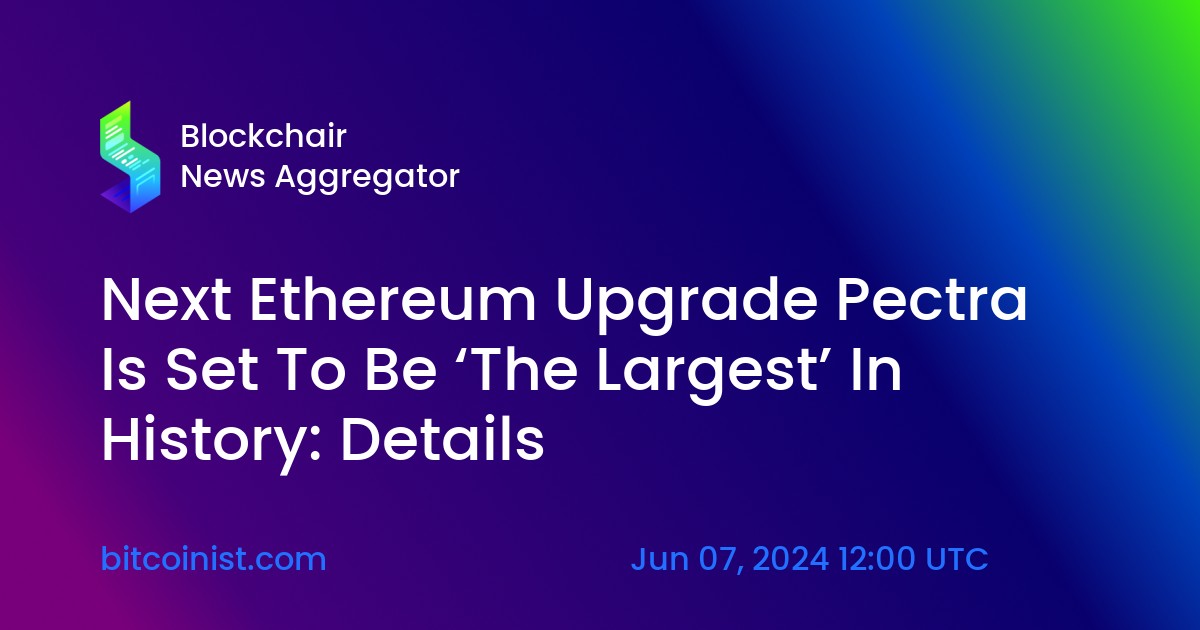Christine Kim, a researcher at Galaxy Digital, has labeled the forthcoming Ethereum upgrade known as Prague-Electra aka Pectra as “possibly the largest in Ethereum’s history.” In a thread on X, Kim laid out the code changes and highlighted how Pectra could fundamentally alter Ethereum’s operational and security paradigms.
Why Ethereum Pectra’s Uprade Is Massive
Pectra follows the successful implementation of the Dencun upgrade, which was rolled out in March 2023, marking it as the next significant advancement for the Ethereum network. It integrates a variety of Ethereum Improvement Proposals (EIPs) that target key aspects of network functionality from cryptographic enhancements to system efficiency improvements. Here’s a closer look at each the Prague changes:
- EIP-2537: This EIP aims to add operations for the BLS12-381 curve as a precompile. This move is crucial for performing operations like BLS signature verification, enhancing security through more robust cryptographic proofs, and facilitating better interoperability with the Ethereum Beacon Chain.
- EIP-2935: Authored by Vitalik Buterin and others, EIP-2935 proposes to store the last 8192 block hashes in storage slots of a system contract. This allows for stateless execution and is a foundational step toward the upcoming Verkle trees upgrade, which aims to drastically reduce state size and improve network scalability.
- EIP-7685: Authored by Lightclient, this proposal introduces a general-purpose bus for sharing EL triggered requests with the CL. Its implementation is expected to streamline the process of code testing and the deployment of execution-triggered requests, such as those related to consensus layer changes.
- EOF (Ethereum Object Format): This is a collection of 10 EIPs that revamp how EVM bytecode is processed. The expected result is an improvement in the dapp developer experience by making smart contract code execution more efficient, logically sound, consistent, and upgradeable.
- EIP-7702: Proposed by Vitalik Buterin, Sam Wilson, Ansgar Dietrichs, and Matt Garnett, this EIP aims to introduce a new transaction type that allows setting the code for an Externally Owned Accounts (EOA) during a transaction. This could significantly enhance user experience by enabling transaction batching, sponsored transactions, and more flexible control over EOAs.
Several key EIPs have been confirmed for the Electra part of the upgrade, addressing crucial aspects of validator operations and system efficiency:
- EIP-6110: This EIP proposes providing validator deposits as a list of deposit operations added to the Execution Layer block. This change simplifies the validator experience by removing the need for deposit voting, reducing client software complexity, and decreasing the delay between submitting a deposit transaction and its processing on the consensus layer.
- EIP-7002: Authored by Danny Ryan and others, this allows validators to trigger exits and partial withdrawals using their execution layer withdrawal credentials, enhancing the design of trustless staking pools.
- EIP-7251 and EIP-7549: These proposals focus on optimizing validator balance configurations and improving the efficiency of attestations within blocks, which could reduce network bandwidth requirements and enhance overall security.
Uncertainties And Timeline
Kim also revealed that “alongside EIPs confirmed for Pectra, devs are also working on a few parallel initiatives like PeerDAS, history expiry, and light client development. Depending on how these go, we could see new EIPs included in Pectra later on.”
She highlights that multiple EIPs are currently being staged for implementation on development networks (devnets), which marks a shift in the Ethereum governance process. This strategic staging allows the community to adjust the upgrade scope based on real-world testing outcomes, ensuring robustness and stability before full deployment.
The active involvement of the Ethereum developer community is crucial, with ongoing discussions, testing, and feedback shaping the final configuration of the Pecta upgrade. The next stages involve further devnet implementations and community reviews, with the potential for some EIPs to be deferred to subsequent upgrades depending on their readiness and impact assessment.
Finally, “it’s unclear how large or small Pectra will actually end up being given that devs aren’t sure what EIPs will be activated together and what they’ll activate separately,” Kim concluded. Ethereum’s core development team has set a target to deploy the Pectra upgrade by the first quarter of 2025.
At press time, ETH traded at $3,807.






